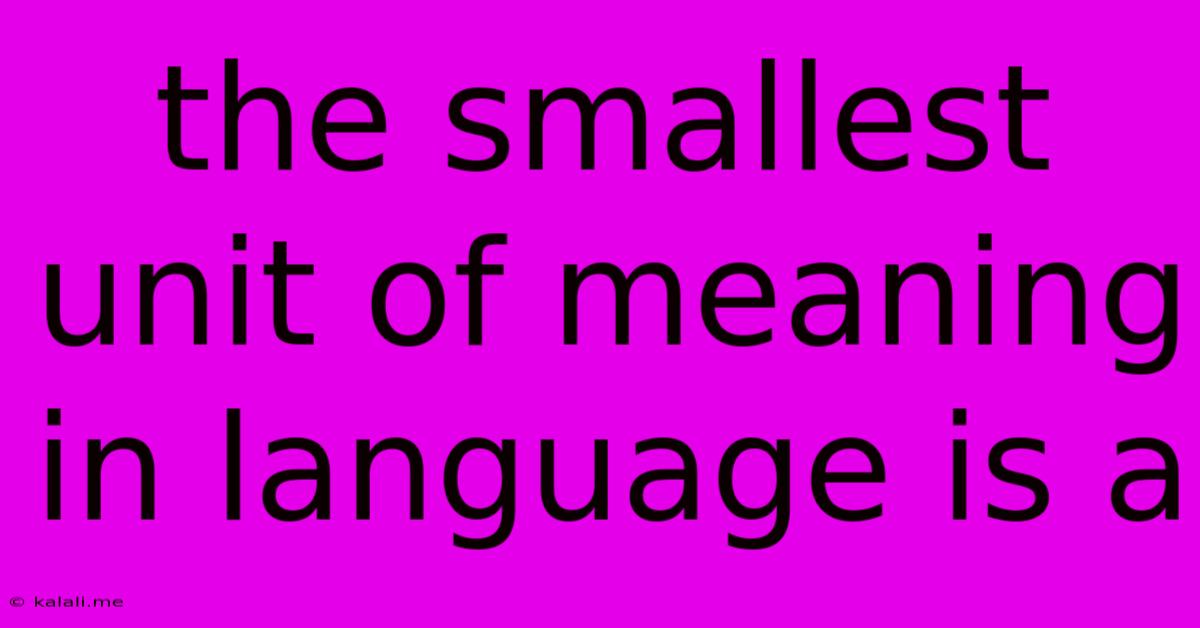The Smallest Unit Of Meaning In Language Is A
Kalali
Jun 12, 2025 · 3 min read

Table of Contents
The Smallest Unit of Meaning in Language is a Morpheme
What is the smallest unit of meaning in language? This seemingly simple question delves into the fascinating world of linguistics and morphology. The answer isn't a letter or a sound, but rather a morpheme. Understanding morphemes is key to unlocking a deeper appreciation of how language is structured and how meaning is conveyed. This article will explore the definition, types, and importance of morphemes in linguistics.
Understanding the concept of a morpheme is crucial for anyone interested in language structure, from students of linguistics to aspiring writers and content creators. This knowledge helps in improving writing clarity, enhancing vocabulary, and even aiding in learning new languages.
What is a Morpheme?
A morpheme is the smallest unit of language that carries meaning. It's a fundamental building block of words, and unlike phonemes (the smallest units of sound), morphemes carry semantic weight. This means they contribute to the overall meaning of a word or phrase. A single word can be composed of one or more morphemes.
Think of it like Lego bricks: each individual brick is a morpheme, and you can combine them in various ways to build larger, more complex structures (words and sentences).
Types of Morphemes
Morphemes are broadly categorized into two main types:
-
Free Morphemes: These morphemes can stand alone as words and still carry meaning. Examples include words like "cat," "dog," "run," and "happy." They are independent units of meaning.
-
Bound Morphemes: These morphemes cannot stand alone; they must be attached to another morpheme (a free morpheme or another bound morpheme) to have meaning. These are often prefixes or suffixes that modify the meaning of the word they're attached to. Examples include "-ing" (as in "running"), "un-" (as in "unhappy"), and "-ed" (as in "walked"). Bound morphemes can be further classified into derivational and inflectional morphemes.
-
Derivational Morphemes: These change the meaning or grammatical category of a word. For example, adding "-ness" to "happy" creates "happiness," changing it from an adjective to a noun. Adding "re-" to "do" creates "redo," changing the meaning of the action.
-
Inflectional Morphemes: These morphemes modify the grammatical function of a word without changing its core meaning. For example, adding "-s" to "cat" creates "cats," indicating plurality, but "cats" still refers to feline creatures. Other examples include tense markers (-ed, -ing), possessive markers ('s), and comparative/superlative markers (-er, -est).
-
Examples of Morphemes in Action
Let's analyze a few words to illustrate the concept:
-
Unbreakable: This word contains three morphemes: "un-" (bound, negative prefix), "break" (free), and "-able" (bound, suffix indicating capability).
-
Cats: This word contains two morphemes: "cat" (free) and "-s" (bound, inflectional suffix indicating plurality).
-
Rewritten: This word has three morphemes: "re-" (bound, prefix indicating repetition), "write" (free), and "-en" (bound, past participle marker).
The Importance of Morphemes in Language Acquisition and Understanding
Understanding morphemes is crucial for several reasons:
-
Language Acquisition: Children learn morphemes as they acquire language, gradually mastering both free and bound forms. This understanding is fundamental to their development of vocabulary and grammar.
-
Vocabulary Building: Recognizing morphemes helps in understanding the meaning of unfamiliar words. If you know the meaning of the morphemes "pre-" (before) and "-cede" (to go), you can deduce the meaning of "precede."
-
Lexical Analysis: Morpheme analysis is vital in computational linguistics and natural language processing (NLP), as it helps computers understand the structure and meaning of text.
In conclusion, the morpheme is the fundamental unit of meaning in language. By understanding its different types and functions, we gain a deeper appreciation for the complexities and beauty of human communication. Its significance stretches across various linguistic fields, from language acquisition to computational linguistics, highlighting its central role in shaping our understanding of language itself.
Latest Posts
Latest Posts
-
Which Of The Following Is Not A Type Of Vaccine
Jun 13, 2025
-
Find Interval Of Convergence Of Power Series Calculator
Jun 13, 2025
-
Which Element Does Not Contain Any Neutrons
Jun 13, 2025
-
A System Is Described By The Following Differential Equation
Jun 13, 2025
-
How Many Molecules In 1 Mole Of Water
Jun 13, 2025
Related Post
Thank you for visiting our website which covers about The Smallest Unit Of Meaning In Language Is A . We hope the information provided has been useful to you. Feel free to contact us if you have any questions or need further assistance. See you next time and don't miss to bookmark.